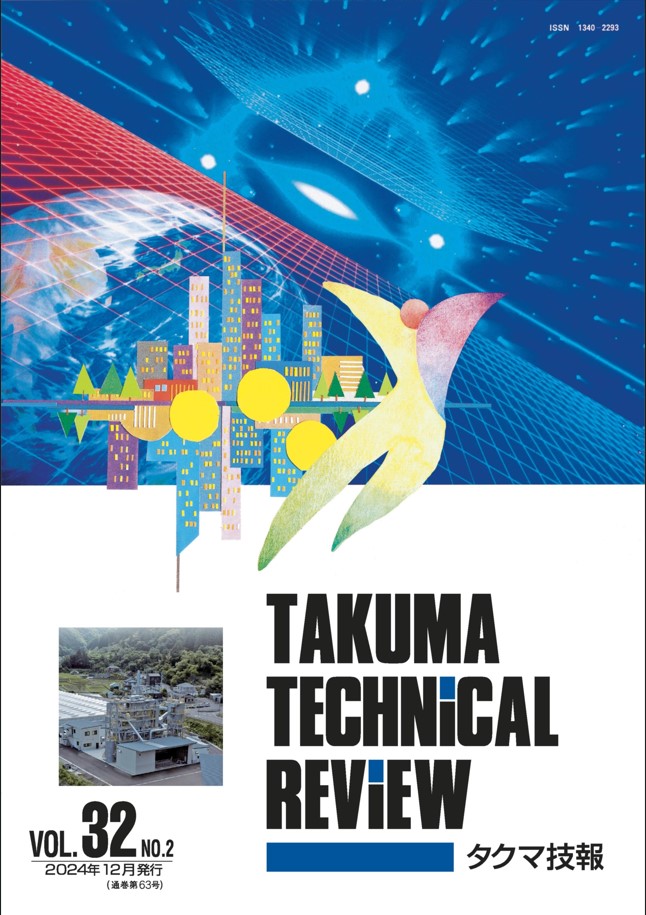

(Abstract)
Much of the combustion phenomena in stoker- type waste incinerators have not been elucidated as they are extremely complex. Meanwhile, there are demands for combustion technology that is based on more detailed understanding of the phenomena in order to cope with future changes in waste quality and environmental regulations that are becoming more stringent. This paper introduces various optical measurement methods and explains their application in measurements of gas velocity, temperature, and chemical species distribution in stoker- type waste incinerators and monitoring inside the incinerator. In addition to their superior temporal and spatial resolution compared with the conventional sampling and measurements using thermocouples, these optical measurement methods offer the advantage of taking measurements without disturbing the combustion field, as they are noncontact methods.
(Abstract)
Japan has positioned a circular economy as a national strategy as a method to simultaneously solve social problems and achieve economic growth. Two key strategies for the transition to a circular economy are the Ministry of Economy, Trade and Industryʼs “Growth- Oriented, Resource- Autonomous Circular Economy Strategy” and the Ministry of the Environmentʼs “The 5th Fundamental Plan for Establishing a Sound Material- Cycle Society.” Based on these strategies, Japan will make efforts to transition to a circular economy. In order to shift to a circular economy, arterial and venous industries ( industries that process natural resources to produce products and industries that turn solid industrial waste into reusable resources, respectively) need to cooperate in the efficient circulation of resources, and a value chain suitable for a circular economy needs to be constructed. Thermal recovery is also an important means of properly disposing of the waste generated even if resources are recycled.
(Abstract)
In biomass power generation, stable procurement of fuel is a major issue not only from the viewpoint of maintaining the operation of existing power plants but also from that of increasing the scale of introduction of biomass power generation. Therefore, there is an increasing need to handle diverse biomass fuels. We explored some new fuels that are expected to be used in the future, focusing on the additional certified fuels under feed- in tariff and feed- in premium scheme, and investigated their characteristics and potential for use as fuel. The characteristics of biomass vary greatly depending on the type, and it is necessary to evaluate the fuels while taking into consideration the differences in production sites and processing conditions. When utilizing new fuels, an important point in achieving optimization of the plant planning is to grasp the characteristics of the fuel through various analyses beforehand and extract the issues. As it is expected that the utilization of various biomass fuels derived from herbaceous resource crops, fast- growing trees, etc. will expand in the future, we also examined the analysis methods to grasp the fuel characteristics and their effects on the boiler equipment to help achieve their utilization.
(Abstract)
Achieving high temperatures in boiler steam is one of the important factors in improving the efficiency of waste power generation. The super-heater tube of the boiler, which produces high-temperature steam, is not only exposed to the high-temperature gas with corrosive properties, but also subject to deposition of combustion ash, which contains various salts, on its surface, and the corrosion is promoted as the steam temperature is increased. We therefore collected the combustion ash depositing to the surface of the super-heater tube in an actual boiler, and used this combustion ash to conduct a combustion ash embedded test while applying a temperature gradient to the ash. This paper reports on the results of our investigation on the initial high temperature corrosion behavior of heat- resistant steel used in super-heater tubes.
(Abstract)
The dust in combustion exhaust gas from the reverse acting grate moving bed stoker- type biomass boiler contains a relatively large amount of unburned matters. Our company often separate, recover and return the unburned matters into the furnace in order to improve combustion efficiency. While we have a multicyclone installed to recover dust from the combustion exhaust gas, the issues with this method include the large pressure loss in the equipment and the wear of the multicyclone. We have therefore promoted the development of louver-type dust collection equipment that can overcome these issues, and conducted a bench-scale test using actual gas. Since we have elucidated the conditions for delivering the unburned matter recovery performance that exceeds the performance of multi- cyclone in this test, we will report on the outline of the test and our results.
(Abstract)
In 2012, the feed-in tariff system was introduced based on the Act on Special Measures Concerning Procurement of Renewable Energy Sourced Electricity by Electricity Utilities. In 2015, a preferential tariff of 40 yen/ kWh was established for woody biomass power generation using thinned lumber of less than 2 MW. In response, our company has commercialized 2 MW- class woody biomass power generation facilities that are applicable nationwide for this category, and delivered 2 facilities in 2018. Currently, a total of 15 orders have been received. This paper explains the transitions of the system of the Act on Special Measures Concerning Procurement of Renewable Energy Sourced Electricity by Electricity Utilities and changes in the environment surrounding the 2 MW- class woody biomass power generation facilities since the initial commercialization, introduces the design changes to respond to these changes, and reports on other facility improvements.